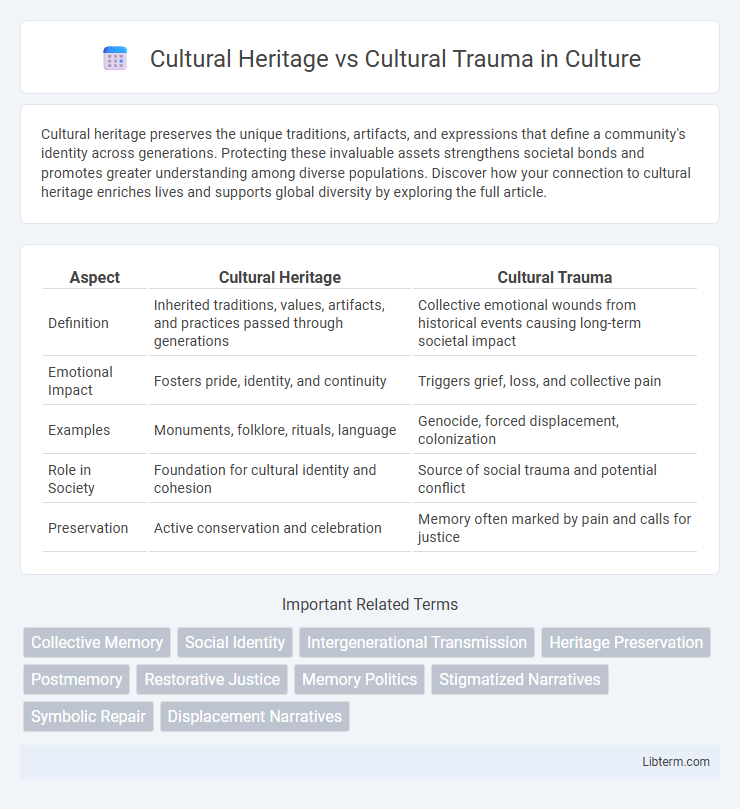Cultural heritage preserves the unique traditions, artifacts, and expressions that define a community's identity across generations. Protecting these invaluable assets strengthens societal bonds and promotes greater understanding among diverse populations. Discover how your connection to cultural heritage enriches lives and supports global diversity by exploring the full article.
Table of Comparison
| Aspect | Cultural Heritage | Cultural Trauma |
|---|---|---|
| Definition | Inherited traditions, values, artifacts, and practices passed through generations | Collective emotional wounds from historical events causing long-term societal impact |
| Emotional Impact | Fosters pride, identity, and continuity | Triggers grief, loss, and collective pain |
| Examples | Monuments, folklore, rituals, language | Genocide, forced displacement, colonization |
| Role in Society | Foundation for cultural identity and cohesion | Source of social trauma and potential conflict |
| Preservation | Active conservation and celebration | Memory often marked by pain and calls for justice |
Defining Cultural Heritage and Cultural Trauma
Cultural heritage encompasses the tangible and intangible assets inherited from previous generations, including monuments, traditions, languages, and artifacts that shape a group's identity. Cultural trauma arises when a collective experiences a deeply distressing event that disrupts the cultural fabric, leading to lasting psychological and social scars. While cultural heritage preserves continuity and identity, cultural trauma challenges and transforms these elements through historical wounds and memory.
Historical Roots of Cultural Heritage
Cultural heritage encompasses the tangible and intangible legacies inherited from past generations, rooted in historical artifacts, traditions, and collective memories that define a community's identity. These historical roots underpin the preservation of languages, customs, monuments, and art forms, serving as a foundation for cultural continuity and pride. In contrast, cultural trauma arises when a community collectively experiences events that disrupt or damage this heritage, leading to altered identities and collective memories shaped by loss and suffering.
Origins and Causes of Cultural Trauma
Cultural trauma originates from collective experiences of severe disruption, such as war, genocide, colonization, or systemic oppression, which inflict lasting damage on a community's identity and memory. These traumatic events fracture social cohesion and create a shared sense of loss, differentiating cultural trauma from cultural heritage, which embodies the preservation and celebration of collective history and values. The causes often involve power imbalances, violence, and forced displacement, leading to narratives of victimhood that influence subsequent generations.
The Role of Memory in Cultural Identity
Memory serves as the cornerstone of cultural identity by preserving shared narratives and traditions that shape a community's sense of belonging and continuity. Cultural heritage embodies positive memories and practices passed down through generations, fostering pride and cohesion. In contrast, cultural trauma disrupts collective memory by embedding experiences of suffering and loss, which can lead to a redefinition or fracturing of identity within the affected group.
Impacts of Cultural Heritage on Community Cohesion
Cultural heritage fosters community cohesion by preserving shared traditions, languages, and values that strengthen collective identity and social bonds. It provides a sense of belonging and continuity, enabling communities to pass down knowledge and practices that reinforce unity across generations. The preservation and celebration of cultural heritage reduce social fragmentation and promote mutual respect among diverse community members.
Effects of Cultural Trauma on Collective Psyche
Cultural trauma profoundly disrupts the collective psyche by instilling a shared sense of loss, mistrust, and identity fragmentation within affected communities. This psychological impact manifests in intergenerational trauma, altering group memory, social behaviors, and collective resilience. Unlike cultural heritage, which fosters pride and continuity, cultural trauma challenges cohesion by embedding narratives of suffering and victimization.
Preservation of Heritage Amidst Trauma
Preserving cultural heritage amidst trauma involves safeguarding traditions, artifacts, and collective memories that define a community's identity despite experiences of conflict, displacement, or loss. Effective preservation strategies include documentation, community engagement, and digital archiving to ensure resilience and continuity of heritage. This approach not only counters the erasure caused by trauma but also fosters healing and cultural revival.
Intergenerational Transmission: Heritage vs. Trauma
Cultural heritage encompasses the preservation and transmission of traditions, values, and practices that strengthen group identity across generations, fostering resilience and continuity. In contrast, cultural trauma involves the intergenerational transmission of collective wounds, memories of suffering, and historical injustices that can perpetuate psychological distress and identity conflicts within descendant communities. Understanding the mechanisms behind both heritage and trauma transmission highlights how narratives and symbols shape communal memory and influence contemporary cultural dynamics.
Strategies for Healing Cultural Wounds
Strategies for healing cultural wounds encompass community-led storytelling, preservation of traditions, and inclusive dialogues that recognize historical trauma. Empowering marginalized groups through education and restorative justice initiatives helps rebuild cultural identity and resilience. Integrating cultural heritage preservation with trauma-informed care fosters collective healing and strengthens social cohesion.
Reconciliation and Revitalization of Cultural Identity
Cultural heritage preserves the traditions, practices, and artifacts that embody a community's historical identity, serving as a foundation for reconciliation by fostering mutual understanding and respect among conflicting groups. Cultural trauma disrupts this continuity by inflicting collective suffering and loss, necessitating active efforts in revitalization to restore a shared sense of identity and cultural pride. Reconciliation processes often revolve around acknowledging past injustices and collaboratively rebuilding cultural narratives to heal wounds and strengthen communal bonds.
Cultural Heritage Infographic

 libterm.com
libterm.com